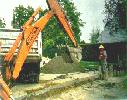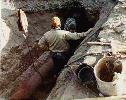 "Network of the Sanitary Sewer System"...
"Network of the Sanitary Sewer System"...
 "Network of the Sanitary Sewer System"...
"Network of the Sanitary Sewer System"...
| Item | Value |
| Design population (for 30 years) | N 30 = 68,000 |
| Domestic water demand | Q d = 195.60 L / sec |
| Domestic water distributed : wastewater collected ratio | P 1 = 1 |
| Return time ratio | P 2 = 2 |
| Density coefficient for big streets | k 1 = 1.5 |
| Density coefficient for small streets | k 2 = 1 |
| Total length of big streets | L 1 = 1,700 m |
| Total length of small streets | L 2 = 17,450 m |
| Upper wastewater flow to manhole no . 4 from manhole no . 2 | Q 2 - 4 = 6.66 L / sec |
| Upper wastewater flow to manhole no . 8 from manhole no . 10 | Q 10 - 8 = 10.00 L / sec |
| Entering depth to manhole no. 4 from manhole no . 2 | h u : 2 - 4 = 2.70 m |
| Entering depth to manhole no. 8 from manhole no . 10 | h u : 10 - 8 = 3.00 m |
| Manning friction coefficient | n M = 0.015 |
 "Design Equations"...
"Design Equations"...
 "Explanatory Cross - Section"...
"Explanatory Cross - Section"...

| From | To | L | k | Lxk | qwastexLxk | Qupper | Qadditional | Qdesign | Z r - from | Z r - to | h u - from | h u - to | Z u - from | Z u - to | Z u - from - Z u - to | J (0%) |
| 5 | 4 | 135 | 1 | 135 | 2.64 | 0.00 | 0.00 | 2.64 | 518.70 | 516.70 | 1.30 | 1.50 | 517.40 | 515.20 | 2.20 | 16.3 |
| 4 | 6 | 155 | 1 | 155 | 3.03 | 9.30 | 0.00 | 12.33 | 516.70 | 515.50 | 2.70 | 2.30 | 514.00 | 513.20 | 0.80 | 5.2 |
| 7 | 6 | 135 | 1 | 135 | 2.64 | 0.00 | 0.00 | 2.64 | 519.20 | 515.50 | 1.30 | 1.50 | 517.90 | 514.00 | 3.90 | 28.9 |
| 6 | 8 | 110 | 1 | 110 | 2.15 | 14.97 | 0.00 | 17.12 | 515.50 | 515.30 | 2.30 | 2.50 | 513.20 | 512.80 | 0.40 | 3.6 |
| 9 | 8 | 135 | 1 | 135 | 2.64 | 0.00 | 0.00 | 2.64 | 520.00 | 515.30 | 1.30 | 1.50 | 518.70 | 513.80 | 4.90 | 36.3 |
| 8 | X | - | - | - | - | 29.76 | 0.00 | - | 515.30 | - | 3.00 | - | 512.30 | - | - | - |
| From | To | D | Qfill | Vfill | Qdesign / Qfill | Vdesign / Vfill | h / D | Vdesign | hdesign | No.drop | Drop | Total drop | Z b - from | Z b - to | Hydraulic regime |
| 5 | 4 | 20 | 36.44 | 1.16 | 0.07 | 0.59 | 0.18 | 0.68 | 3.6 | - | - | - | 517.20 | 515.00 | Turbulence |
| 4 | 6 | 20 | 20.42 | 0.65 | 0.60 | 1.04 | 0.56 | 0.68 | 11.2 | - | - | - | 513.80 | 513.00 | Turbulence |
| 7 | 6 | 20 | 48.38 | 1.54 | 0.05 | 0.54 | 0.15 | 0.83 | 3.0 | - | - | - | 517.70 | 513.80 | Turbulence |
| 6 | 8 | 30 | 50.19 | 0.71 | 0.34 | 0.91 | 0.40 | 0.65 | 12.0 | - | - | - | 512.90 | 512.50 | Turbulence |
| 9 | 8 | 20 | 54.04 | 1.72 | 0.05 | 0.54 | 0.15 | 0.93 | 3.0 | - | - | - | 518.50 | 513.60 | Turbulence |
| 8 | X | 30 | - | - | - | - | - | - | - | - | - | - | 512.00 | - | - |
 "Hydraulic Elements"...
"Hydraulic Elements"...
| Q / (g/d)1/2(D)5/2 | h critical / D |
| 0.0001 | 0.01 |
| 0.0010 | 0.03 |
| 0.0027 | 0.05 |
| 0.0107 | 0.10 |
| 0.0238 | 0.15 |
| 0.0418 | 0.20 |
| 0.0646 | 0.25 |
| 0.0921 | 0.30 |
| 0.1241 | 0.35 |
| 0.1603 | 0.40 |
| 0.2011 | 0.45 |
| 0.2459 | 0.50 |
| 0.2949 | 0.55 |
| 0.3484 | 0.60 |
 "Longitudal Cross - Section of Street 5 - 4"...
"Longitudal Cross - Section of Street 5 - 4"...

| Population | Population info served by sanitay sewer system | ||
| Total | Percentage in Türkiye's population | Percentage in municipalities' population | |
| - 2,001 | 99,409 | 0.70 | 15.93 |
| 2,001 - 5,000 | 1,004,101 | 18.10 | 23.84 |
| 5,001 - 10,000 | 1,182,409 | 37.83 | 38.25 |
| 10,001 - 25,000 | 2,439,255 | 55.09 | 55.26 |
| 25,001 - 50,000 | 2,249,988 | 57.96 | 57.96 |
| 50,001 - 100,000 | 3,923,162 | 76.94 | 76.94 |
| 100,001 - 500,000 | 7,127,200 | 79.08 | 79.08 |
| 500,001 - 1,000,000 | 1,513,948 | 65.15 | 65.15 |
| 1,000,001 - 5,000,000 | 6,297,613 | 89.14 | 89.14 |
| 5,000,000 + | 7,327,047 | 90.00 | 90.00 |
| Türkiye | 33,164,131 | 53 | 69 |
 Click here for the "Detailed Information about the Infrastructure Systems of Türkiye ( In Turkish )"...
Click here for the "Detailed Information about the Infrastructure Systems of Türkiye ( In Turkish )"...
 Click here for the Source : "State Statistics Institute"...
Click here for the Source : "State Statistics Institute"...
| Constants | Variables (try different values until the conditions are satisfied) |
| n = 0.013 | Dia = 27 in |
| 7.5 ft3 / sec | S = 0.001 |


